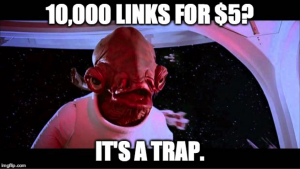The world of SEO is fraught with perilous pitfalls.
Fortunately, you don’t have to travel alone. Use this guide to make sure you avoid common mishaps that can sink websites in Search Engine Results Pages (SERPs).
1. Avoid Negative Ranking Factors for Local SEO
Not only can smart SEO help elevate your presence in search results, incorrect or poorly implanted tactics can actually drop your site in the SERPs.
Beware the following negative ranking factors:
- Inconsistent NAP (Name, Address and Phone) information across the web
- Inaccurate category listings in directories and on your Google, Bing and Yahoo profiles
- Keyword stuffing (i.e., inserting excessive keywords in your content to fool search engines)
- Duplicate Google My Business pages
- No crawlable NAP information on your site
- Negative reviews
Moz’s Local Search Ranking Factors guide includes a complete list of negative ranking factors to avoid.
2. Remove or Consolidate Duplicate Citations & Directory Listings
If you have multiple listings for the same location on one directory or platform (for example, two Google My Business pages or two different directory listings with different addresses for the same location), make sure the incorrect duplicates are removed, updated, or merged with the correct listing. Ultimately, aim for just one accurate listing per site, directory or platform.
For help with this task, we recommend using Moz Local. The free version of this useful tool should be all you need to identify duplicate directory listings. However, stepping up to the paid version can save you time since it automates the process of uploading your data to directories, ensuring total NAP consistency.
3. Steer Clear of Google Search Engine Penalties
Ignoring (or even willfully breaking) search engine guidelines for ethical SEO can land your site in serious trouble. Google may even penalize your site, demote your search rankings or possibly remove your site from its index altogether.
Here the main penalties to keep in mind:
Failing to Consider Google’s Pigeon Update
With the introduction of Google’s Pigeon algorithm in 2014, traditional ranking factors now carry more weight in determining local search results as well. It’s important to make sure you have the basics of site structure and SEO best practices nailed down on your site, even if ranking in local search results is your primary concern.
Thin Content (Panda)
Search engines want to ensure they send users to websites that can satisfy their queries. To do this, they ensure that websites feature enough copy, images, videos and other content to be able to answer the users’ questions. After all, nobody likes to click a link to what sounds like an interesting page, only to find it’s mostly blank or doesn’t have the information we need.
This is where Google’s Panda algorithm comes into play. Introduced in 2011, it detects sites with thin content and demotes their rankings in favor of stronger websites with better content. To avoid being slapped with a penalty from Panda, follow these steps:
- Ensure you have enough copy on your pages to address user needs
- Include photos and videos (if they might be relevant or useful)
Link Spam (Penguin)
One pioneering innovation behind Google’s search engine was the discovery that links between websites could be used to improve search results. In fact, of the more than 200 different factors that Google uses to rank websites, backlinks weighted at around 70% of what determines ranking results. The more links your site receives from other relevant and high quality sites, then the more likely your site is to rank well.
So what’s stopping you from creating tons of junk websites just to point links back to your own site, or even paying other sites to link to you?
The answer is Google’s Penguin algorithm, which detects manipulative link spam tactics. Do the right thing, and obtain links naturally by creating and sharing high-quality content that others want to share, without trying to take any shortcuts (like creating low-quality sites with fake content and links back to your real business website).
Wait … How Do I Know If My Site Has Been Penalized?
If your site does get hit with such a penalty, Google’s recovery process is often tedious and time-intensive. It’s best not to get in trouble in the first place. However, if you suspect you may be under a penalty, the first place to check is in your Google Search Console account. If you’re under a penalty, you’ll see a message such as this:

Are there any common local SEO traps we’ve left out? Chat with us on Twitter @sundogtweets. You may also be interested in downloading our comprehensive white paper “Winning at Local SEO.”


